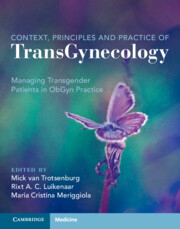Book contents
- Context, Principles, and Practice of Transgynecology
- Context, Principles, and Practice of Transgynecology
- Copyright page
- Dedication
- Contents
- Foreword
- Preface
- Contributors
- Abbreviations
- Section A Contextual Transgynecology
- Section B Practicing Transgynecology
- Section C Gynecological Surgery for Transgender Males
- Section D Sexuality and Contraception
- Section E Fertility and Reproduction
- Section F Impact of Gender-affirming Hormonal Therapy on Genital Organs
- Section G Screening and Prophylaxis
- Chapter 34 Prevention and Management of Neovaginal Stenosis and Other Related Complications of Vaginoplasty
- Chapter 35 Pelvic Physical Therapy for Gender-affirming Genital Vaginoplasty
- Chapter 36 HPV-associated Dysplasia of Skin and Mucosa and Vaccination Options in Trans People
- Chapter 37 Extent, Burden, and Characteristics of STDs and HIV in Trans People
- Chapter 38 Screening Policies for Cervical, (Neo-)Vaginal, and Vulvar Dysplasia and Cancer
- Transgynecology Index
- References
Chapter 38 - Screening Policies for Cervical, (Neo-)Vaginal, and Vulvar Dysplasia and Cancer
from Section G - Screening and Prophylaxis
Published online by Cambridge University Press: 22 December 2022
- Context, Principles, and Practice of Transgynecology
- Context, Principles, and Practice of Transgynecology
- Copyright page
- Dedication
- Contents
- Foreword
- Preface
- Contributors
- Abbreviations
- Section A Contextual Transgynecology
- Section B Practicing Transgynecology
- Section C Gynecological Surgery for Transgender Males
- Section D Sexuality and Contraception
- Section E Fertility and Reproduction
- Section F Impact of Gender-affirming Hormonal Therapy on Genital Organs
- Section G Screening and Prophylaxis
- Chapter 34 Prevention and Management of Neovaginal Stenosis and Other Related Complications of Vaginoplasty
- Chapter 35 Pelvic Physical Therapy for Gender-affirming Genital Vaginoplasty
- Chapter 36 HPV-associated Dysplasia of Skin and Mucosa and Vaccination Options in Trans People
- Chapter 37 Extent, Burden, and Characteristics of STDs and HIV in Trans People
- Chapter 38 Screening Policies for Cervical, (Neo-)Vaginal, and Vulvar Dysplasia and Cancer
- Transgynecology Index
- References
Summary
As medicine evolves, the traditional healthcare model that reflects societal binary systems is changing to become more inclusive of the transgender population. This is especially true in the field of gynecology and physicians have started to recognize the need for more research in the transgender population as it is particularly vulnerable due to healthcare disparities. Here, we conducted a literature review to help guide for gynecological cancer screening in the transgender population. We found that the transgender population is particularly at risk for infection with the human papilloma virus (HPV) and thus, should be encouraged to undergo preventative vaccination. In this chapter we will highlight screening policies in cervical cancer in the transgender male population, particularly for individuals who have not undergone gender-affirmation surgery. The rarity of vulvar and vaginal cancers in the transgender population have made it difficult to implement routine screening policies and patients should be screened on an individual basis in the presence of concerning symptoms. We also discuss screening skepticism in the transgender population and different techniques physicians can employ to improve their practice. It is our goal that through this chapter a physician can gain a deeper understanding and appreciation when caring for this unique patient population.
- Type
- Chapter
- Information
- Context, Principles and Practice of TransGynecologyManaging Transgender Patients in ObGyn Practice, pp. 281 - 284Publisher: Cambridge University PressPrint publication year: 2022



